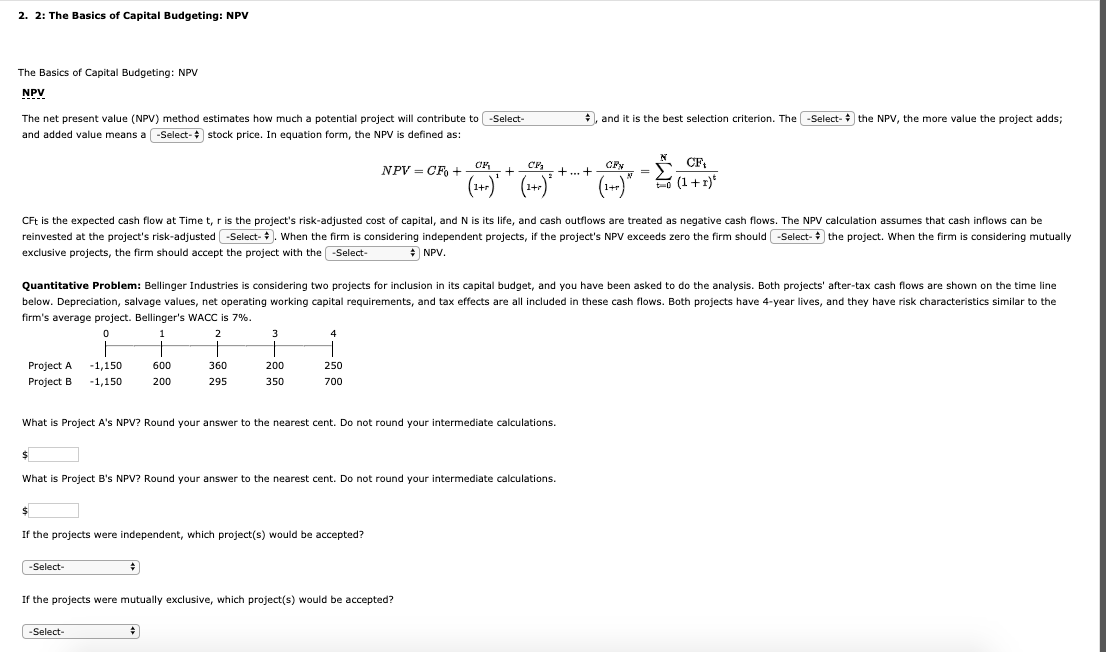Question
The Basics of Capital Budgeting: IRR IRR A project's internal rate of return (IRR) is the -Select-compound ratediscount raterisk-free rateCorrect 1 of Item 1 that
The Basics of Capital Budgeting: IRR
IRR A project's internal rate of return (IRR) is the -Select-compound ratediscount raterisk-free rateCorrect 1 of Item 1 that forces the PV of its inflows to equal its cost. The IRR is an estimate of the project's rate of return, and it is comparable to the -Select-YTMcoupongainCorrect 2 of Item 1 on a bond. The equation for calculating the IRR is:
CFt is the expected cash flow in Period t and cash outflows are treated as negative cash flows. There must be a change in cash flow signs to calculate the IRR. The IRR equation is simply the NPV equation solved for the particular discount rate that causes NPV to equal -Select-IRRonezeroCorrect 3 of Item 1. The IRR calculation assumes that cash flows are reinvested at the -Select-IRRNPVWACCCorrect 4 of Item 1. If the IRR is -Select-lessgreaterCorrect 5 of Item 1 than the project's risk-adjusted cost of capital, then the project should be accepted; however, if the IRR is less than the project's risk-adjusted cost of capital, then the project should be -Select-acceptedrejectedCorrect 6 of Item 1. Because of the IRR reinvestment rate assumption, when -Select-mutually exclusiveindependentCorrect 7 of Item 1 projects are evaluated the IRR approach can lead to conflicting results from the NPV method. Two basic conditions can lead to conflicts between NPV and IRR: -Select-returntimingpreferenceCorrect 8 of Item 1 differences (earlier cash flows in one project vs. later cash flows in the other project) and project size (the cost of one project is larger than the other). When mutually exclusive projects are considered, then the -Select-IRRNPVCorrect 9 of Item 1 method should be used to evaluate projects. Quantitative Problem: Bellinger Industries is considering two projects for inclusion in its capital budget, and you have been asked to do the analysis. Both projects' after-tax cash flows are shown on the time line below. Depreciation, salvage values, net operating working capital requirements, and tax effects are all included in these cash flows. Both projects have 4-year lives, and they have risk characteristics similar to the firm's average project. Bellinger's WACC is 9%.
| 0 | 1 | 2 | 3 | 4 | ||||||
| Project A | -1,000 | 650 | 320 | 270 | 390 | |||||
| Project B | -1,000 | 250 | 255 | 420 | 840 | |||||
What is Project As IRR? Do not round intermediate calculations. Round your answer to two decimal places. %
What is Project B's IRR? Do not round intermediate calculations. Round your answer to two decimal places. %
If the projects were independent, which project(s) would be accepted according to the IRR method? -Select-NeitherProject AProject BBoth projects A and BCorrect 1 of Item 3 If the projects were mutually exclusive, which project(s) would be accepted according to the IRR method? -Select-Neither Project AProject BBoth projects A and BCorrect 2 of Item 3 Could there be a conflict with project acceptance between the NPV and IRR approaches when projects are mutually exclusive? -Select-YesNoCorrect 3 of Item 3 The reason is -Select-the NPV and IRR approaches use the same reinvestment rate assumption so both approaches reach the same project acceptance when mutually projects are considered.the NPV and IRR approaches use different reinvestment rate assumptions so there can be a conflict in project acceptance when mutually exclusive projects are considered.Correct 4 of Item 3 Reinvestment at the -Select-IRRWACCCorrect 5 of Item 3 is the superior assumption, so when mutually exclusive projects are evaluated the -Select-NPVIRRCorrect 6 of Item 3 approach should be used for the capital budgeting decision.

Step by Step Solution
There are 3 Steps involved in it
Step: 1

Get Instant Access to Expert-Tailored Solutions
See step-by-step solutions with expert insights and AI powered tools for academic success
Step: 2

Step: 3

Ace Your Homework with AI
Get the answers you need in no time with our AI-driven, step-by-step assistance
Get Started


